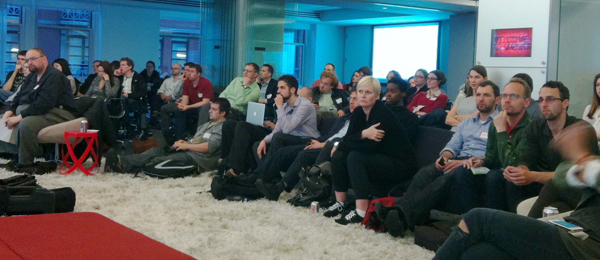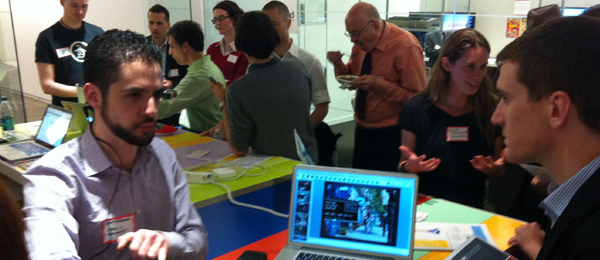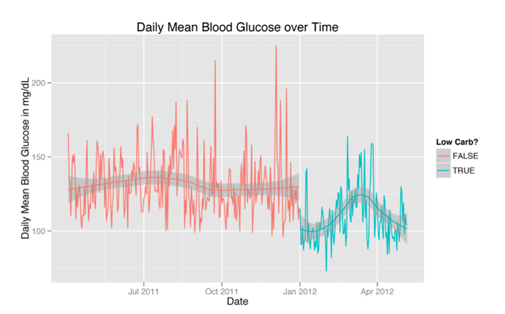New York QS Show&Tell #16 Recap
Steven Dean
May 14, 2012

Last week we had over a 100 folks attend our 16th NY Show&Tell with a Demo Hour held on Tuesday, May 8th at an incredible space that was generously provided by Digitas, a digital brand agency that has watched and supported QS closely over the years.
Thank you to my co-organizers, Ben Ahrens and Brian Gallegos, who helped pull together this recap for the blog.
DIGITAS LABS DEMO HOUR
Digitas Labs and Ben Ahrens assembled a fascinating group of QS members to share their stories, innovations and experiences in our first demo hour that had a real science fair feel. Some of the demos ran on some awesome touch screen devices provided by Digitas Labs. It started at 6pm with the following demonstrations:

Zack Freedman demos Optigon
Sandy Santra gave a lively demonstration of a truly unique DIY self-tracking system built for the iPad that not only charts psychological changes and their effects, but also provides users with full editorial control over data fields and allows them to customize their own personal experiments.
Kat Houghton, founder of ilumivu, displayed a wearable emotional state detector designed to empower people with the ability to tap into their own behavior and the behavioral responses of children with autism to help facilitate positive health and lifestyle changes.
Folks gathered in the Innovation Room as Alex Smith demonstrated his software called “Timebinder” which he designed to create visual timelines out of timestamped data — particularly useful for bringing asynchronous time series data from multiple sources into a single view for analysis.
Craig Dunuloff took spectators through a virtual blast into the past with his app Rewind.me. Where was that restaurant? How may friends were there? What did the gang do last night? This app allows users to get more value out of what they’ve done in their lives by aggregating data from other services such as Facebook, Foursquare, Tripit, Runkeeper, and more. It also lets you see and compare your activities to those of your friends and the world at large.
Amelia Rocchi gave QS members a behind the scenes look at InsideTracker – a web-based service that helps individuals optimize their overall health and performance by giving them a unique view into their personal biochemistry.
Christian Monterroza unveiled his time-tracking project that uses geo-fencing to passively track and organize daily activity. One of the most fascinating and helpful aspects of Christian’s app is that it allows the user to easily and personally allocate different regions of spaces for different activities, i.e., the park is for running; the freeway for driving; the living room for sitting; the grocery store for food shopping, etc. The app then takes over and auto-logs the activities based on its users geography. Fully customizable – NO LOGGING REQUIRED!
Zack Freedman (@ZackFreedman) was quick to draw a crowd with “Optigon” – a wearable wireless cyborg system that integrates with the user’s smartphone allowing him or her to access all data and keep it in plain site – even view nearby mobile user’s text messages, or as Zack puts it, “read people’s minds”! This awesome demo was every bit as impressive as it looked. Zack is currently seeking partners and investment to turn his devious device into the Arduino of wearables.
SHOW&TELL TALKS
Following the demo hour, we had four inspiring talks from QS members of the NY community.
How analytics improved my personal life and helped a losing soccer team
 Stefan Heeke has a background in analytics and wanted to start using this skill for three self-improvement projects.
Stefan Heeke has a background in analytics and wanted to start using this skill for three self-improvement projects.
The first project was measuring his physical health. He was using the Fitbit to track his activity. He discovered that it takes some time at the beginning but then eventually he discovered what works for him. Specifically, he identified three areas: don’t eat fried food, cut out snacks, and cut out alcohol.
The next project was a daily journal. He decided to write down numbers to better understand how he feels each day. He found that he could gather some very actionable data by correlating the right metrics with each other. His approach is to identify both a positive and negative correlation to the activity. For example, he would correlate stress, whether he had a successful day, or general feelings of satisfaction. He also tracked his commuting time. He wanted to figure out how his daily commute impacts his mood. He found that as his personal time available decreased, his food quality decreased and his television time increased. Overall, he found that a) social days are good days, b) proximity to work is important, c) stuff in general has no impact, and d) TV is a time killer.
The third thing he tracked is how to apply personal metrics to a soccer team. He tried to model the most probable outcomes for certain soccer scenarios in terms of likelihood of success. As a result of the tracking, the team made it to the finals of the soccer league.
Ultimately, Stefan learned that whenever you apply data, it has a transformative impact and if you want to improve your life, data can help. He was also surprised at the number of distractions he ran into and how much that had an impact on his life.
Quantifying Diabetes
Jana Beck started her self-tracking journey with the goal of better understanding the impact of her diabetes. She was diagnosed with type 1 diabetes at age 19 and has been dependent on synthetic insulin for survival since. Her problem is that dosing insulin is not easy and is not a one-size-fits-all thing. It requires a lot of adjustment and impacts people differently. She set out to better understand her diabetes and better optimize her glucose management.

She started using a continuous glucose monitor on the back of her arm last year. This device transmits blood readings every 5 minutes and she gets trend and rate of change information. She has a target goal of keeping her readings between 70 and 130 mg/DL.
Her first experience was shock and her next was frustration. She found it hard to change her patterns. So she developed a hypothesis and set out to test it. Her hypothesis is that she needs to restructure her carbohydrate intake. The first step was to read a book on the topic (Good Calories / Bad Calories by Gary Taubes). The next was to use her monitoring device to track how her glucose changed based on her changes in carbohydrate intake. Her conclusion is that a low carbohydrate diet had a significant impact on her readings.
To run her analytics, Jana built her own statistical analysis program using R that tracks daily percentages over time for each type of blood sugar reading (carb-restricted vs. regular diet) against a target. Her program is called iPancreas and is available on Github.
Her next step is to try and start pulling in other variables (exercise, mood, etc.) to see how this changes her patterns. Ultimately, Jana’s self tracking project taught her how to best eat so that she can control her diabetes.
Walk all of Manhattan
 Alastair Tse recently moved to NYC six months ago to work at Google. He hadn’t spent much time in NYC previous to moving here and wanted to better discover his new home city. Each day he commutes from 27th St. to 14th St. in Manhattan. One day he was trying to figure out the optimal route to work and wondered how many patterns are there to get from point A (home) to point B (work). He further extrapolated on this idea to see if it’s possible to walk all of Manhattan, and track it.
Alastair Tse recently moved to NYC six months ago to work at Google. He hadn’t spent much time in NYC previous to moving here and wanted to better discover his new home city. Each day he commutes from 27th St. to 14th St. in Manhattan. One day he was trying to figure out the optimal route to work and wondered how many patterns are there to get from point A (home) to point B (work). He further extrapolated on this idea to see if it’s possible to walk all of Manhattan, and track it.
He started by writing down his walking experience in a notebook and just using general Google Maps. This turned out to be a bad idea because it wasn’t scalable and Google Maps can be buggy. So he built his own mapping app that uses Google Maps but allows him to map his own routes. The app tracks the streets he goes down and allows him to edit each route. It then tracks the routes he takes and shows his walking history.
He learned that it was possible to track something like where in a city a person walks and it’s very useful. In fact, he found that he hadn’t walked one square block north and one square block south of his apartment, much to his surprise. It got him to wonder, what other areas of the city is he often near, but never explored. The app helped Alastair adjust to living in a brand new city and has given him some ideas for places he wants to eventually explore.
How visualizing health problems could help solve medical mysteries
Katie McCurdy is an interaction designer with Myasthenia gravis, an auto-immune disease that causes muscle weakness in voluntary muscles She’s had it for 20 years and has been taking a drug to help the disease. She decided to take an alternate route and consult a holistic doctor. This was a new doctor so she was very motivated to make sure this new doctor understood her entire 20 year history with the disease. So she decided to make a timeline, from memory. She drew a timeline that included when she was feeling good and when she was feeling bad. She annotated the timeline for when she took certain drugs.

Initially, this was all drawn by hand. But as she worked on it, she decided to digitize it. So she next built the timeline into Adobe Illustrator so the graphs can be more accurately represented.
But it wasn’t enough to see all of her mood timelines separately. She wanted to overlay them so when symptoms go up and down, she can see how they are associated with each other.
Two variables she tracked were gut feelings (physical) and voice strength. These are two areas in which the muscle constriction has a high and very noticeable impact. This experience has helped her tell her story in a structured and coherent way and for that reason, this entire project has been helpful.
She learned that antibiotics were probably making her sicker, that docs are busy and probably skeptical of yet another patient created graph, that better health visualizations can be a great storytelling tool, and that memories are data too. Ultimately, she ended up being inspired and is currently doing more focused tracking in other areas of her life.
See our interview with Katie in an earlier QS post here.
Thanks to everyone who came out. We’ll get the videos up soon. See you this summer at the next NY QS Show&Tell.


